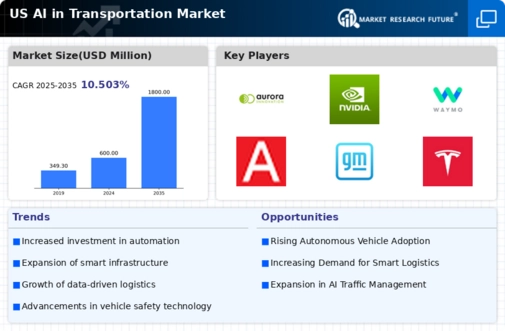Technological Advancements in AI
The rapid evolution of artificial intelligence technologies is a primary driver in the ai in-transportation market. Innovations in machine learning, computer vision, and natural language processing are enhancing the capabilities of transportation systems. For instance, AI algorithms are now capable of processing vast amounts of data in real-time, which improves decision-making in logistics and fleet management. According to recent estimates, the AI market in transportation is projected to reach approximately $10 billion by 2025, reflecting a compound annual growth rate (CAGR) of around 15%. This growth is indicative of the increasing reliance on AI to optimize routes, reduce operational costs, and enhance overall efficiency in transportation networks.
Government Initiatives and Funding
Government support plays a crucial role in the growth of the ai in-transportation market. Various federal and state initiatives are aimed at promoting the adoption of AI technologies in transportation systems. For example, the U.S. Department of Transportation has allocated significant funding for research and development projects that focus on smart transportation solutions. In 2025, it is estimated that federal investments in AI-related transportation projects could exceed $1 billion. This financial backing not only accelerates technological advancements but also encourages public-private partnerships, fostering innovation and enhancing the overall infrastructure of transportation systems across the nation.
Rising Demand for Autonomous Vehicles
The increasing consumer interest in autonomous vehicles is a significant driver of the ai in-transportation market. As safety concerns and the desire for convenience grow, more individuals are considering self-driving technology. Market Research Future indicates that by 2025, the sales of autonomous vehicles in the U.S. could reach 1 million units annually. This surge is likely to be fueled by advancements in AI that enhance vehicle safety and navigation systems. Consequently, automotive manufacturers are investing heavily in AI technologies to develop vehicles that can operate independently, thereby transforming the landscape of personal and commercial transportation.
Integration of AI in Supply Chain Management
The integration of AI technologies into supply chain management is reshaping the ai in-transportation market. Companies are increasingly leveraging AI to optimize logistics, inventory management, and demand forecasting. By utilizing AI-driven analytics, businesses can enhance operational efficiency and reduce costs. In 2025, it is projected that AI applications in supply chain management could save U.S. companies over $50 billion annually. This trend indicates a growing recognition of AI's potential to streamline transportation processes, improve delivery times, and enhance customer satisfaction, thereby driving further investment in AI technologies.
Consumer Expectations for Enhanced Mobility Solutions
Shifting consumer expectations regarding mobility solutions are influencing the ai in-transportation market. As urban populations grow, there is a rising demand for efficient, reliable, and sustainable transportation options. Consumers are increasingly seeking integrated mobility solutions that utilize AI to provide real-time information and seamless travel experiences. In 2025, it is anticipated that the demand for AI-driven mobility services will increase by approximately 30%. This trend suggests that transportation providers must adapt to changing consumer preferences by incorporating AI technologies to enhance service delivery and meet the evolving needs of urban commuters.





















Leave a Comment